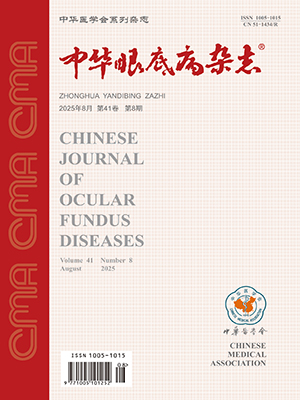| 1. |
Jonas JB, Budde WM, Panda-Jonas S. Cataract surgery combined with transpupillary silicone oil removal through planned posterior capsulotomy[J]. Ophthalmology, 1998, 105(7): 1234-1237. DOI: 10.1016/S0161-6420(98)97026-9.
|
| 2. |
Cheng L, Azen SP, El-Bradey MH, et al. Duration of vitrectomy and postoperative cataract in the vitrectomy for macular hole study[J]. Am J Ophthalmol, 2001, 132(6): 881-887. DOI: 10.1016/s0002-9394(01)01263-6.
|
| 3. |
Karacorlu M, Hocaoglu M, Sayman Muslubas I, et al. Primary vitrectomy with short-term silicone oil tamponade for uncomplicated rhegmatogenous retinal detachment[J]. Int Ophthalmol, 2019, 39(1): 117-124. DOI: 10.1007/s10792-017-0787-9.
|
| 4. |
Issa R, Xia T, Zarbin MA, et al. Silicone oil removal: post-operative complications[J]. Eye (Lond), 2020, 34(3): 537-543. DOI: 10.1038/s41433-019-0551-7.
|
| 5. |
Oliveira RA, Magalhaes Junior O, Rossi J, et al. Complications of silicone oil as vitreous tamponade in pars plana vitrectomy: a mini review[J]. Curr Eye Res, 2025, 50(4): 353-361. DOI: 10.1080/02713683.2024.2409883.
|
| 6. |
Soliman MK, Hardin JS, Jawed F, et al. A database study of visual outcomes and intraoperative complications of postvitrectomy cataract surgery[J]. Ophthalmology, 2018, 125(11): 1683-1691. DOI: 10.1016/j.ophtha.2018.05.027.
|
| 7. |
邵敬芝, 杜珊珊, 袁超峰, 等. 硅油取出联合晶状体超声乳化术中3 种取油方式效果比较[J]. 中华眼外伤职业眼病杂志, 2022, 44(4): 246-252. DOI: 10.3760/cma.j.cn116022-20211007-00353.Shao JZ, Du SS, Yuan CF, et al. Comparison of efficacy among three methods of silicone oil removal combined with phacoemulsification[J]. Chin J Ocul Traum Occupat Eye Dis, 2022, 44(4): 246-252. DOI: 10.3760/cma.j.cn116022-20211007-00353.
|
| 8. |
王应飞, 吴众. 自制灌注器进行硅油取出联合白内障超声乳化术的临床观察[J]. 中华眼外伤职业眼病杂志, 2022, 44(4): 273-278. DOI: 10.3760/cma.j.cn116022-20211123-00438.Wang YF, Wu Z. Clinical observation of self-made infusion cannula-assisted silicone oil removal combined with phacoemulsification cataract surgery[J]. Chin J Ocul Traum Occupat Eye Dis, 2022, 44(4): 273-278. DOI: 10.3760/cma.j.cn116022-20211123-00438.
|
| 9. |
Zhu YC, Yuan DQ, Xie P, et al. Phacoemulsification combined with transpupillary removal of silicone oil and intracapsular intraocular lens implantation[J]. Int J Ophthalmol, 2017, 10(11): 1693-1697. DOI: 10.18240/ijo.2017.11.09.
|
| 10. |
Goezinne F, Nuijts RM, Liem AT, et al. Corneal endothelial cell density after vitrectomy with silicone oil for complex retinal detachments[J]. Retina, 2014, 34(2): 228-236. DOI: 10.1097/IAE.0b013e3182979b88.
|
| 11. |
Dada VK, Talwar D, Sharma N, et al. Phacoemulsification combined with silicone oil removal through a posterior capsulorhexis[J]. J Cataract Refract Surg, 2001, 27(8): 1243-1247. DOI: 10.1016/s0886-3350(00)00864-6.
|
| 12. |
Thulasidas M, Gupta H, Sachdev MS, et al. Microincision phacoemulsification combined with sutureless transpupillary passive silicone oil removal[J]. Indian J Ophthalmol, 2021, 69(9): 2311-2316. DOI: 10.4103/ijo.IJO_3538_20.
|
| 13. |
Boscia F, Cardascia N, Sborgia L, et al. Evaluation of corneal damage by combined phacoemulsification and passive efflux of silicone oil in vitrectomized eyes[J]. J Cataract Refract Surg, 2003, 29(6): 1120-1126. DOI: 10.1016/s0886-3350(03)00069-5.
|
| 14. |
Cacciatori M, Aspinall P, Bennett HG, et al. Corneal endothelial evaluation after phacoemulsification and silicone oil removal via an anterior approach[J]. Retina, 2007, 27(6): 755-758. DOI: 10.1097/IAE.0b013e31802eacce.
|
| 15. |
荣翱, 李厚硕, 李雯, 等. 硅油取出联合白内障超声乳化术的临床探讨[J]. 中国实用眼科杂志, 2007, 25(9): 1026-1028. DOI: 10.3760/cma.j.issn.1006-4443.2007.09.031.Rong A, Li HS, Li W, et al. Clinical investigation of concurrent silicone oil removal and phacoemulsification cataract surgery[J]. Chin J Pract Ophthalmol, 2007, 25(9): 1026-1028. DOI: 10.3760/cma.j.issn.1006-4443.2007.09.031.
|
| 16. |
Diaz-Valle D, Benitez Del Castillo Sanchez JM, Toledano N, et al. Endothelial morphological and functional evaluation after cataract surgery[J]. Eur J Ophthalmol, 1996, 6(3): 242-245. DOI: 10.1177/112067219600600303.
|
| 17. |
Dick HB, Kohnen T, Jacobi FK, et al. Long-term endothelial cell loss following phacoemulsification through a temporal clear corneal incision[J]. J Cataract Refract Surg, 1996, 22(1): 63-71. DOI: 10.1016/s0886-3350(96)80272-0.
|




